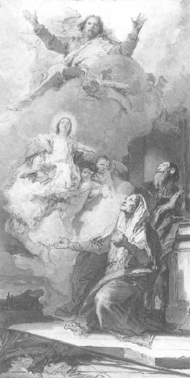
fig. 2
G.B. Tiepolo, The vision of St Anne, Amsterdam, Rijksmuseum
apparitio dictate, they who appear must also disappear, for those who represent salvation are viewed only briefly.
Clouds were also used in scenes that are far more static, those in which it is important to make a distinction between heaven and earth. Above, God sits enthroned, perhaps with the Virgin Mary and Jesus, amid the heavenly host; below is the earth, the realm to which the viewer belongs, aspiring to a future place above. But a footpath of clouds linking ‘above’ with ‘below,’ as in Schwabe's watercolour, is highly unusual. For while it is the function of clouds to separate heaven and earth, both in static and dynamic representations, here a cloud-path connects them. With this motif, Carlos Schwabe has devised something exceptional.
This work makes the impossibe possible. But how possible is it? Who, for example, can walk on clouds? The answer is: Schwabe's Madonna. In order to achieve this, however, she has been completely deprived of her corporality: in fact, she is little more than a translucent gown. Her child is so ethereal that only His eyes provide some kind of certainty. And from the single lily Mary received from Gabriel upon his annunciation of the Saviour's virgin birth, Schwabe has made an entire hedge, running along the cloud-path. The radiant haloes, attributes of sainthood, contribute to the transparency of the figures' presence.
The viewer could meet the Virgin halfway down the cloud-path, but then he, too, would have to become free of his body. The fin de siècle was characterised by a longing for spiritualisation, for the transcendence of material existence. In Carlos Schwabe's world, the most celebrated spokesman of this desire was Joséphin Péladan, the founder of the Salon de la Rose + Croix. In 1892 Schwabe designed the poster for its first exhibition (fig. 3). Two years later he painted the Madonna with lilies (Lausanne, private collection), the first in a long series to which the Van Gogh Museum version (1899) also belongs. While both works have the same theme, in the poster the upward path is a staircase on which lilies grow, and the ‘ethereal’ is given a somewhat more straightforward symbolisation, in that the woman on the higher tread is simply presented in outline. The cloud-path in the watercolour takes the viewer from darkness into light, and on that road Mary awaits him. Although seen here with her son, she is not really shown as the Mother of God, and neither figure is represented as a saviour. They merely look down towards the mortals below, who are free to set out on the journey of self-transcendence. The Virgin personifies a spiritual ideal; she is a symbol of something incorporeal. It thus became possible for a Protestant like Carlos Schwabe to accept her.
Behind this symbolic imagery lies a concept of redemption which, despite its many Christian elements, is not essentially Christian in nature. Although Schwabe's watercolour is a kind of altarpiece, and although it is the Virgin whom we encounter as we transcend the world, this work actually encourages spiritual self-activation. It rises